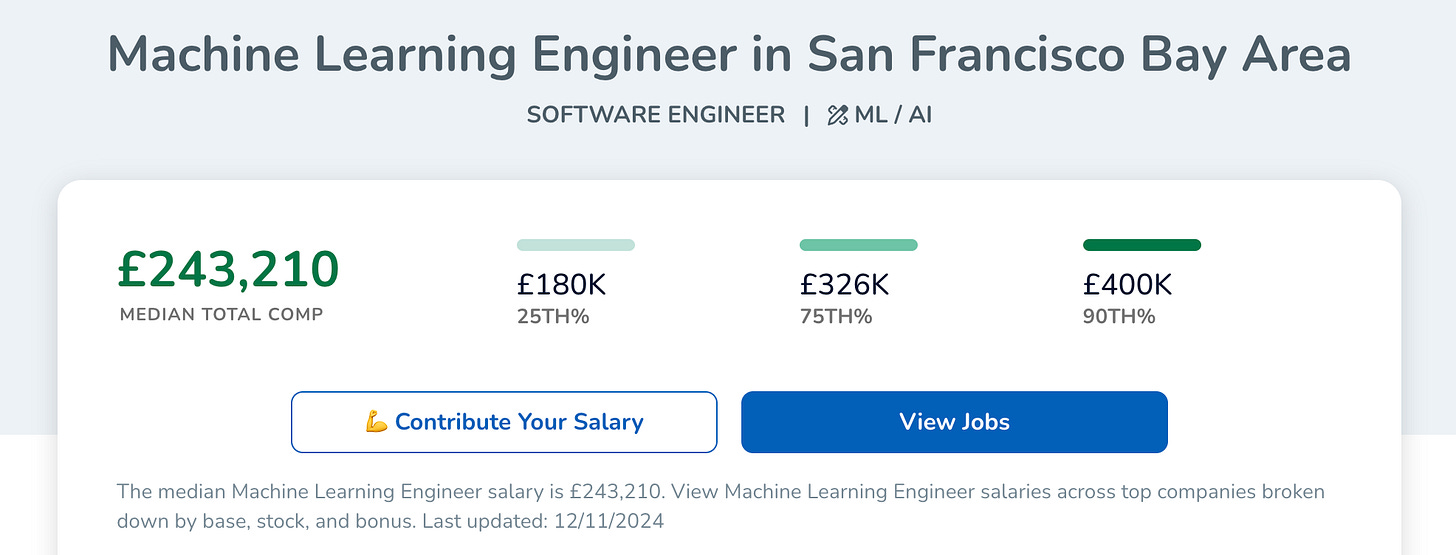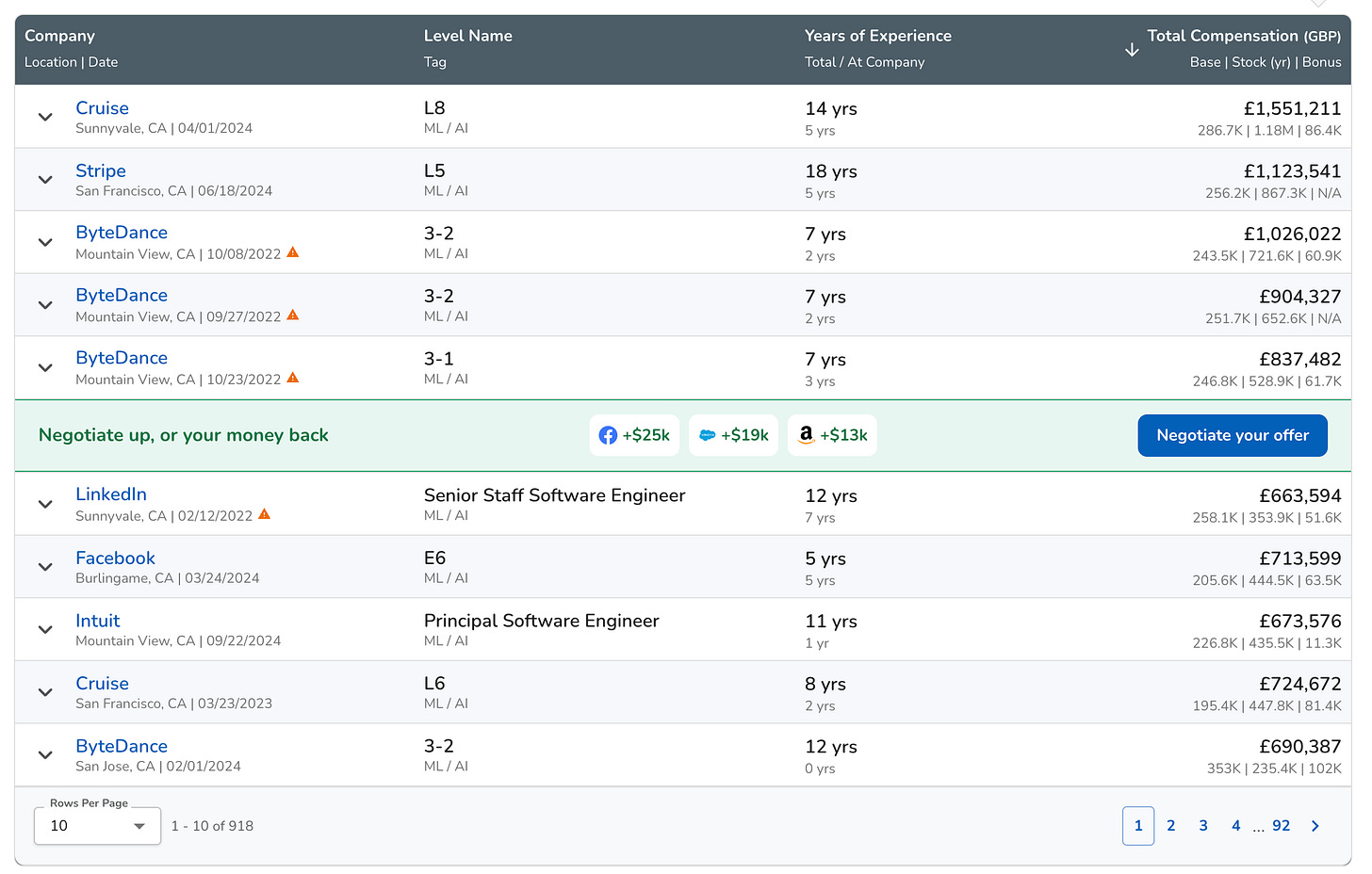The Real-World Guide to Machine Learning Careers in 2025
Navigating ML Jobs, Salaries, and Interviews at Top Tech Companies
Hey there! So you're thinking about getting into machine learning? Perfect timing!
Let me guess - you've probably spent hours scrolling through ML job postings, watching YouTube tutorials about neural networks, and maybe even started a few Coursera courses. But you're still wondering: "What do these companies actually want? And more importantly, how do I get there?" Well, you're in the right place.
In this guide, I'm going to break down everything I wish someone had told me when I started my ML journey. We'll look at what the job market really looks like right now (spoiler: it's pretty exciting!), dive into the different types of ML roles out there (because no, not everything is about training models), and I'll give you the inside scoop on how interviews actually work at the big tech companies.
And yes, we'll talk about the good stuff too - like those impressive salary numbers you might have heard about. So grab your favorite caffeinated beverage, and let's dive into everything you need to know about landing a machine learning role in today's market.
Show Me the Money: The ML Job Market Right Now
Let me paint you a picture of what's really happening in ML right now. Remember when every company was rushing to slap "AI-powered" on their products just because they could? Well, those days are gone! Now, it's getting really interesting - companies aren't just looking for people who can run model.fit() and call it a day. They want problem solvers who can look at a messy business challenge and think, "Hmm, I know exactly how ML can fix this!"
Here's what I'm seeing in the trenches: companies are hungry for ML practitioners who understand the full story. And by full story, I mean everything from "Hey, here's our business problem" all the way to "Look at this beautiful ML system running in production and actually making money!" It's not just about knowing your algorithms anymore - it's about building systems that work in the real world.
And now for everyone's favorite part - let's talk money! According to Levels.fyi (my go-to site for salary snooping), ML engineer roles are pulling in a median salary of 243k GBP. Not too shabby, right? But wait, it gets better! If you specialize in hot areas like large language models or AI safety, you could be looking at even juicier packages. Just a simple sorting on the levels.FYI site suggests that there are a few options in terms of high-paying companies out there if you are looking to get a job in ML. Obviously, you can’t take a Million dollar pay for granted and the levels differ in each company but still good to know that such things exist.
Also, the field is growing like crazy! Companies aren't just hiring senior folks - they're building out entire ML teams, which means more entry-level positions. I'm seeing more and more companies offering solid "ML Engineer I" or "Junior Applied Scientist" roles. They're realizing they need to grow their ML talent from the ground up, not just poach senior engineers from Google and Meta.
And you know what's cool? The variety of industries jumping into ML is increasing every day. It's not just the usual tech suspects anymore - I'm talking healthcare, finance, retail, even agriculture, and oh so many startups and SME industries looking to integrate ML into their existing systems! So whether you're passionate about helping doctors diagnose diseases faster or want to help fight climate change with smart energy systems, there's probably an ML role out there for you.
Pick Your Path: The ML Career Menu
Now as you are sold about the lucrativeness of this career opportunity, let’s break down the main types of ML roles you might encounter. Think of these as different paths you can take, each with its unique challenges and rewards. It will always pay to understand what role fits you best. For me, it is the ML Engineer role but don’t let it deter you. All the roles given below are equally lucrative and you must choose which suits you the best rather than looking for recommendations from other folks. That said I recommend the ML Engineer role :) :
ML Engineer
If you love building things and want to see your models make an impact while looking at them end to end, this might be your path. ML Engineers are the folks who turn research papers and prototypes into robust, production-ready systems.
What will your day look like? You’ll:
Build data pipelines that can handle real-world messiness
Create and Deploy models that need to work reliably at 3 AM
Make sure your systems scale without breaking the bank so you need to look into Cost Explorer for cloud-based systems and understand your systems invariably well.
Collaborate with teams to integrate ML into larger applications
You’ll need to be comfortable with Python (or Java/Go), know your way around ML frameworks like PyTorch or TensorFlow, and understand how to build reliable distributed systems. Think of yourself as the bridge between cutting-edge ML and practical engineering.
Research Scientist
Research Scientists focus on advancing the fundamental understanding of ML/AI, often working on longer-term, more open-ended problems. The role typically involves:
Leading novel research initiatives that push the boundaries of ML/AI
Developing new theoretical frameworks and methodologies
Publishing high-impact papers at top-tier conferences (NeurIPS, ICML, ICLR, etc.)
Building research prototypes to validate theoretical work
Mentoring junior researchers and PhD interns
Setting research agendas and identifying promising directions
This role is a pretty specialist role and typically requires a PhD and a strong mathematics background. You will also need to demonstrate a strong publication record at top conferences. But beyond the formal requirements, you’ll need an insatiable curiosity and the patience to pursue ideas that might not work out. This role would also require a Deep theoretical understanding of ML/AI fundamentals, and interviews might grill you a lot on that.
Applied Scientist
Applied Scientists bridge the gap between pure research and practical applications, but with a stronger emphasis on novel research and methodology than the description suggests. You’ll spend your time:
Conducting original research to solve complex business problems - this means not just adapting existing research but often developing new algorithms, approaches, or methodologies
Developing and testing hypotheses through rigorous experimentation and statistical analysis
Working closely with product teams to identify research opportunities and translate business problems into scientific questions
Publishing papers and contributing to the scientific community while focusing on practical applications
Building proof-of-concept systems that demonstrate novel approaches
They're expected to push the boundaries of what's possible, often publishing their findings, while keeping practical applications in mind. Most Applied Scientist roles require a PhD precisely because they need someone who can do novel research, not just implement existing solutions. They're different from Research Scientists mainly in that their research problems are derived from business needs rather than open-ended scientific exploration
ML Platform Engineer
ML Platform Engineers build and maintain the infrastructure that enables ML development and deployment at scale. Their role combines ML expertise with distributed systems and software engineering. Key responsibilities include:
System architecture at scale
Platform reliability and fault tolerance
Developer productivity and experience
Infrastructure cost optimization
Security and compliance requirements
Integration with existing development workflows
Think of yourself as an enabler – your work makes it possible for other ML practitioners to be more productive. You would primarily work on internal systems in a company enabling ML practitioners to focus on their core work (building models, solving problems) rather than dealing with infrastructure challenges.
Here’s something really important to understand about all these roles: they’re not rigid boxes you’ll be stuck in forever. The ML field moves incredibly fast, and the most successful professionals are those who embrace continuous learning. I’ve seen plenty of ML Engineers transition into Research Scientist roles after diving deep into a particular problem area, and Research Scientists move into Applied Scientist roles when they want to see their work make an immediate impact.
Especially in smaller companies or startups, you might find yourself wearing multiple hats. One day you could be fine-tuning a model, the next day setting up deployment pipelines, and the day after that presenting findings to business stakeholders. This flexibility can be incredibly valuable for your career growth – it helps you develop a holistic understanding of ML systems that makes you more effective in any role you choose.
So don’t feel pressured to pick your “forever role” right now. Focus on building a strong foundation, and stay curious about different aspects of ML. Your career path might surprise you!
Cracking the Interview Code: What to Really Expect?
Let’s walk through what you can expect when interviewing at major tech companies. The process might seem daunting, but I’ll break it down into manageable pieces.
It typically starts with an initial screen – think of it as a conversation to make sure there’s a basic match. You’ll chat with a recruiter and maybe do some basic technical questions. Nothing too scary, usually about 30-45 minutes.
Then comes the real technical assessment – you’ll have one or two phone interviews focusing on coding and ML concepts. These are usually 45-60 minutes each. Pro tip: Practice explaining your thought process out loud while coding. It makes a huge difference!
The interview process for machine learning roles at top technology companies typically spans 4-6 weeks and follows a structured format. Understanding this process is crucial for effective preparation and success.
If all goes well, you’ll move to the onsite interviews (or virtual loop these days). This is the big day – you’ll typically have 4-6 interviews covering:
Coding - Can you write clean, efficient code?: Coding rounds focus on algorithmic problem-solving and data structures, with additional emphasis on ML-specific implementations. Companies like Google and Meta often include one or two pure coding rounds to ensure strong programming foundations. These rounds assess your ability to write clean, efficient code while explaining your thought process.
ML system design - How would you build a real ML system?: Machine learning theory rounds delve into the fundamentals of ML algorithms, model selection, and optimization techniques. Google particularly emphasizes statistical understanding, while Meta often focuses on practical applications of ML concepts.
Behavioral questions - How do you work with others?: Behavioral rounds evaluate your collaboration skills, leadership experience, and cultural fit. Amazon strongly emphasizes its leadership principles, while Google looks for “Googlyness.” These interviews often involve discussing past projects, challenges overcome, and team interactions.
Team fit- Can they see you as a colleague: The process typically concludes with a team-matching phase, particularly at larger companies like Google, where candidates interact with potential teams after receiving an offer. Smaller companies or specific teams might integrate team matching into the interview process itself.
Some companies might also ask you to:
Complete a take-home coding assignment
Give a research presentation
Do a system design presentation
Here is a blog from yours truly that is about the fateful Day I gave the Meta Interview for ML Engineer. It is a good read so make sure to at least skim through it.
Your Learning Roadmap (Trust Me, You'll Want This!)
Okay, let's talk about the elephant in the room - how do you learn all this stuff? Don't worry, I've got your back! Here's the roadmap I wish someone had handed me when I started.
First things first - you need to get your foundations solid. Think of it like building a house. You wouldn't start with the roof, right? Same here! Start with Python (and trust me, make it Python - yes, R is great, but Python is where the jobs are). You don't need to become a Python guru, but you should be comfortable enough to write clean code without constantly Googling basic syntax. This specialization from the University of Michigan is about learning to use Python and creating things on your own.
Next up is the math. I know, I know - you probably thought you were done with math after college! But here's the thing: you don't need to become a math professor. Focus on the practical stuff. Linear algebra? Absolutely. Basic calculus? Yep. Probability? You bet. And you can get all of it at once in this one specialization from deeplearning.ai —Mathematics for Machine Learning is a beginner-friendly Specialization where you can learn the fundamental mathematics toolkit of machine learning: calculus, linear algebra, statistics, and probability.
But here's a secret - you don't need to learn everything at once. If you want to keep the math part for later, you can start with Andrew Ng's Machine Learning course (My fiercest recommendation as I still go back to its lecture notes) on Coursera or dive into fast.ai if you prefer a more hands-on approach.
Now comes the fun part - getting your hands dirty with real projects. Kaggle is your new best friend here. It's like a playground for ML enthusiasts, complete with datasets, competitions, and a super helpful community. Start with the Titanic dataset (it's like the "Hello World" of ML), but don’t stop there, and honestly don’t add it to your resume for god’s sake. Do some real competitions next and the goal while working at Kaggle, should not be to get medals(Although that will be great if you get one) but to understand how folks approach the various problems and learn how ML engineers focus and work on these problems.
But here's something many people miss - don't just do tutorials and courses. Build stuff! Create a GitHub portfolio. Here is mine for instance. It doesn't have to be groundbreaking - maybe a sentiment analyzer for Twitter posts, or a simple image classifier. The key is to build something end-to-end that you can actually show people.
And speaking of people - get involved in the community! Join ML Discord servers (there are tons of great ones out there), subscribe to ML-focused substacks(Maybe subscribe to mine if you haven’t ready, and start following some ML practitioners on X or LinkedIn. Trust me, the ML community is incredibly welcoming to newcomers. We've all been there!
Also, if you can, start writing about what you're learning. It doesn't have to be fancy - just start a simple blog on Medium or Substack. Writing helps you learn better, and bonus: it shows potential employers that you can communicate technical concepts clearly.
The Bottom Line: Your ML Journey Starts Now
Alright, let's wrap this up! If you've made it this far, you've probably realized that getting into ML isn't as mysterious as it might have seemed at first. Sure, there's a lot to learn, but it's definitely doable with the right approach and mindset.
Remember how we started talking about those seemingly impossible job requirements? Well, now you know that different roles need different skills - you don't need to be a math PhD and a distributed systems expert and a deep learning guru all at once. Whether you're more excited about building production systems as an ML Engineer, pushing the boundaries of what's possible as a Research Scientist, or something in between, there's probably a role that fits your interests and skills.
As for those interviews we talked about - yes, they're challenging, but now you know what to expect. And trust me, the companies aren't looking for perfection - they're looking for people who can solve real problems and work well with others. Sometimes that means knowing when to use a simple solution instead of the fanciest neural network architecture.
Want my final piece of advice? Pick the role that genuinely interests you (even if it's not the ML Engineer role I recommended - I'll try not to take it personally!), create a study plan based on the interview process we discussed, and start practicing. Oh, and definitely check out my Meta interview experience I mentioned - nothing beats learning from someone else's journey (and mistakes)!
The ML field is moving fast, the salaries are great (as those Levels.fyi numbers showed), and there's still plenty of room for newcomers who are willing to put in the work. So what are you waiting for? Time to turn those ML dreams into reality!








https://open.substack.com/pub/hustlercoder/p/technical-and-architectural-expertise-9f7?r=1f5fq7&utm_campaign=post&utm_medium=web&showWelcomeOnShare=false
Thanks for the clarity Rahul. Specially regards to roles and responsibilities. Just some follow up questions
We also see the role for Data Engineers these days where they take large amounts of structured and mostly unstructured data, apply software engineering and ML magic to convert it into data that can be consumed by the resarchers/applied schientists etc. How and where do they fit in ?
As per your article, can we say Researchers/Applied Researchers == Data Scientists ? How would you relate/differentiate, as specially in India I see the role of Data Scientists being very prominent.